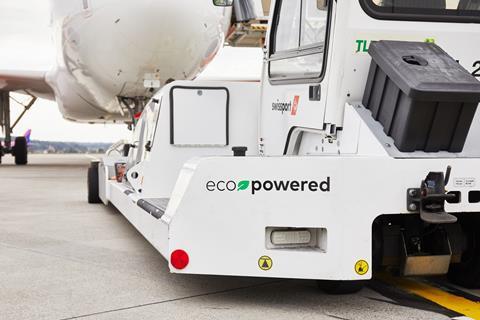In the high-profile, high-stakes drive to decarbonise aviation, all eyes are on the skies and evolving efforts to cut aircraft emissions.
But at ground level, significant moves are also underway to cut emissions before, between, and after flights.
From terminal to takeoff, and from touchdown back to terminal, extended emissions of air travel are substantial.

Among the biggest sources are aircraft taxiing or idling, and the flurry of diesel-fuelled vehicles which push, pull, cater, carry, shuttle, and lift for every flight.
Airports, airlines, ground handling companies, and equipment makers are collaborating to address surface issues with more low-or-no emission vehicles, sophisticated support systems, and even airport-generated fuels. It’s a race to ground zero.
Major ground handling companies have pledged steep cuts in their emissions, Dnata 50% by 2030, Swissport 42% by 2032, and Menzies carbon neutral by 2033. Each has prioritised electrification of airport vehicles, Swissport quantifying 55% within 10 years.
At Amsterdam’s Schiphol airport, 40% of ground service vehicles are already electrically-powered, and in January, remaining diesel vehicles were switched to HVO100, a plant-based substitute fuel said to emit 98% less CO2.
As part of the airport’s net zero 2030 target, trials are also underway of two diesel-electric ‘TaxiBot’ tugs, driverless tractors which tow aircraft between terminals and runways, instead of them taxiing under their own power.
Taxi time for departing planes averages 14 minutes, while arrivals take around nine to reach the terminal. And getting to or from ‘Polderbaan’, Schiphol’s furthest runway, can take up to 19 minutes. Initial tests with Boeing 737s and Airbus A320s towed at regular taxi speeds indicate an average 50% reduction in total fuel burn, and up to 65% for ‘Polderbaan.’
Air India, too, has trialled TaxiBots, and plans to introduce them at Delhi and Bengaluru airports.
In Singapore, which is developing a ‘sustainable air hub’ strategy, the 15 recommendations of an independent advisory panel include not only switching airside vehicles to electric, hydrogen or biofuel propulsion, but on-site conversion of waste to energy to help power all airport functions.
Although airlines use techniques like single-engine taxiing, and are moving towards sustainable fuels, there are still significant emissions from aircraft just standing still, their lighting, avionics, and air conditioning run by onboard, fossil-fuelled auxiliary power units (APUs). To help reduce APU use, airports increasingly are supplying ground power and pre-conditioned air to planes parked at terminals.
“These products allow aircraft to shut down their APUs for 30 minutes or more each time they come into a gate,” explains JBT Aerotech, a major US-based manufacturer of such equipment. “This seemingly-small operational change results in huge environmental benefits.”
For each gallon of jet fuel consumed, the company says 21 pounds of greenhouse gases (GHG) are produced. Calculating that APUs of different-sized aircraft burn 34-to-114 gallons per hour, then multiplying the data by thousands of turnarounds each day, JBT concludes that the ground power and preconditioned air units it has supplied in North America alone helped prevent 3.5 million tons of GHG per year.
United Airlines, one of the industry’s most proactive sustainability advocates, operates around 4,000 electric vehicles or equipment units, one third of its ground service fleet.
To support increased electrification and charging of equipment, United Airlines Ventures recently invested in battery maker Natron Energy. “United has made substantial investments in companies developing technology to reduce aircraft emissions,” says the airline. “Natron is the first that has the potential to reduce the greenhouse gas footprint from ground operations.”
But as with new technologies to decarbonise flight, costs rise as emissions fall. By 2050, says a new, industry-sponsored report, the cost of converting airport ground operations just in Europe will be 9 billion Euros, while updating airport infrastructure will be another 18 billion.


























